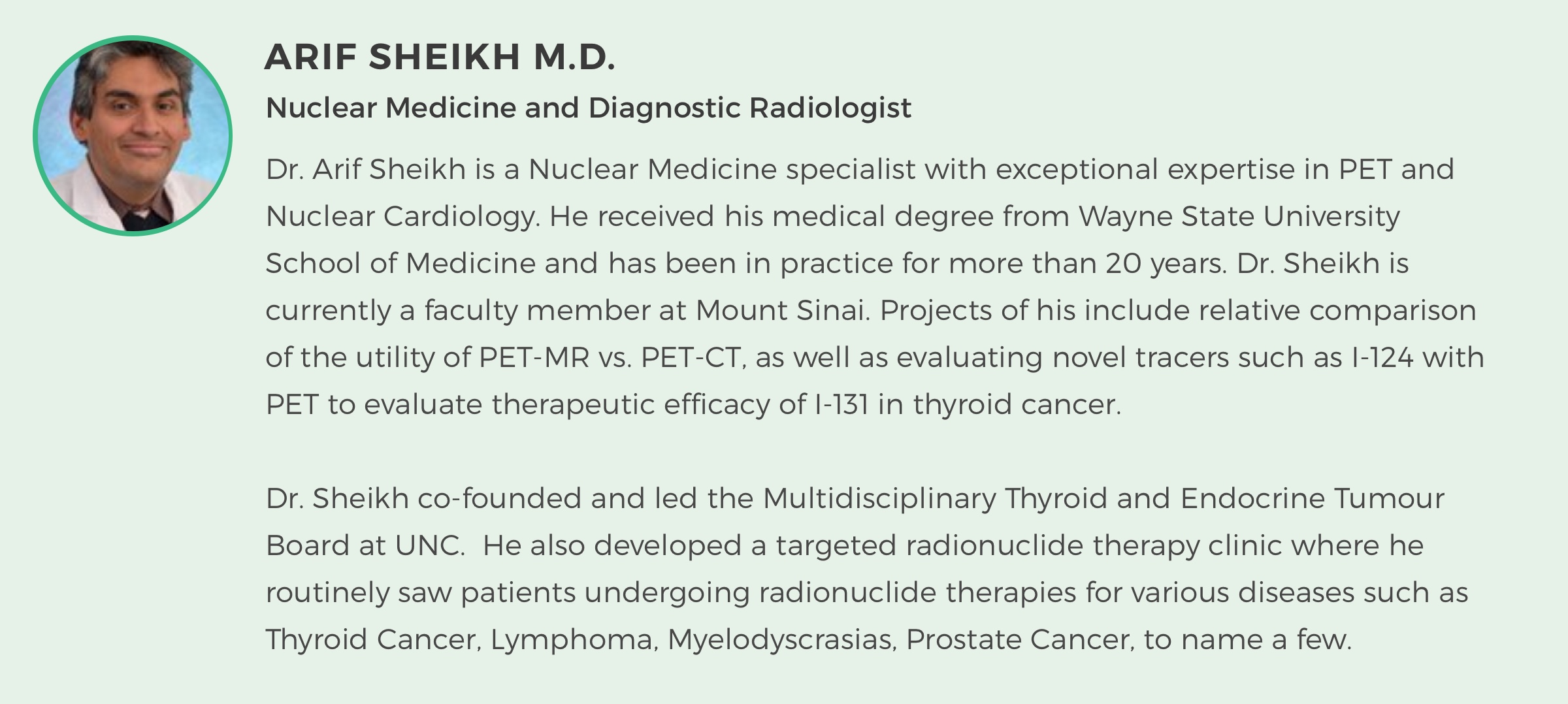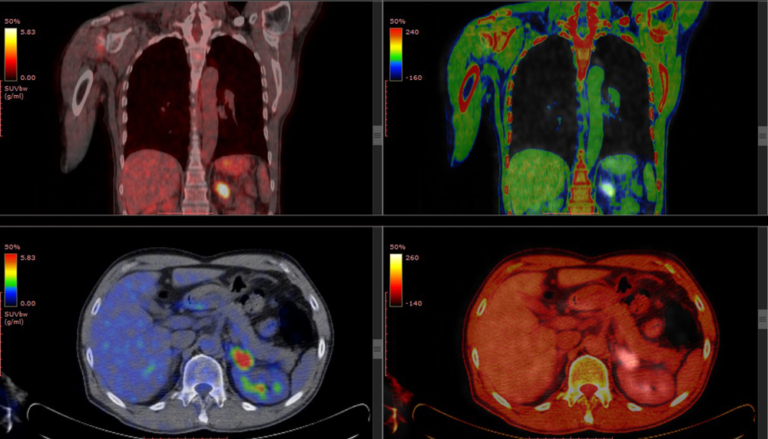An FDG PET scan is one of the most powerful tools we have to detect and monitor disease.
Most often used in conjunction with CT or MRI, it helps radiologists distinguish between healthy tissue and diseased tissue so that cancer can be accurately diagnosed, correctly staged, and appropriately treated.
But for many patients and their loved ones, the complexity of an FDG PET scan can make the experience of getting one confusing and challenging to navigate. To better understand how an FDG PET scan works and its advantages, we spoke with one of DocPanel’s lead nuclear medicine experts and Mount Sinai faculty member, Dr. Arif Sheikh.
From what FDG uptake means to how to interpret SUV value, Dr. Sheikh takes us through the basics and shares valuable tips on the importance of getting a second opinion on your FDG PET scan.
DocPanel is committed to making sure every patient gets an accurate diagnosis. If you would like an expert second opinion on your medical imaging scan from Dr. Sheikh or one of our other subspecialists, you can learn more here.
What Is Your FDG PET Scan Report Saying? (FDG Uptake, SUV & More)
[DocPanel] What is FDG uptake? Does FDG uptake indicate the presence of cancer?
[Dr. Sheikh]
For many patients who get an FDG PET scan, their number one question is in relation to understanding what FDG uptake means. Whether their report says ‘no FDG uptake,’ ‘abnormal FDG uptake,’ ‘low grade FDG uptake,’ or any other variation – there’s usually no explanation noted on the report to help patients understand what this means.
FDG uptake refers to the amount of radiotracer uptake. There’s a perception among patients that anything with uptake is abnormal. However, this is not always true and can cause unnecessary alarm and concern.
When determining what FDG uptake is indicative of, the interpreting radiologist must also take into consideration any findings on CT, MRI, or other imaging tests. Given the complexity – one really has to specialize in PET and have read a lot of FDG PET scans to understand all the variables and intricacies.
So while a patient can take their report to their oncologist or primary health provider for an explanation of what their results mean – they also want to be sure that the scan was interpreted correctly.
[DocPanel] What role can a second opinion play in determining FDG uptake results?
[Dr. Sheikh]
Getting a second opinion allows patients to have the peace of mind that a nuclear medicine expert has reviewed their scans.
With DocPanel, for example, patients who submit their FDG PET scan for a second opinion also have the opportunity to ask specific questions to the radiologist about their scan. A patient may not have this opportunity otherwise. This not only provides more information to the patient – but also more information for the referring provider (your primary doctor).
Interested in learning about getting an FDG PET scan second opinion? You can learn more and get started here.
[DocPanel] What is SUV value?
[Dr. Sheikh]
An FDG PET scan report will also indicate SUV (standardized uptake value). While it is natural to believe a higher SUV indicates greater malignancy – that is absolutely not the case.
SUV is a measure used for monitoring purposes, to see how things change over time. People shouldn’t necessarily be concerned about it, even if the numbers do change dramatically. SUV changes are meant to be interpreted as a part of the overall picture of what’s going. It’s not a black and white indication.
On a CT scan, let’s say you have a 1cm tumor and it doubles in size – now it all depends on the type of cancer and the type of treatment but in most cases, people will say yes – that suggests to me that the disease has progressed.
Likewise, in a scenario when an FDG PET scan SUV doubles in intensity over time, it’s common to assume the disease has progressed. But in actuality, that’s not always necessarily the case. Six-month changes have to be an overall assessment. Not just a matter of whether the numbers are going up or down. An SUV value is one of the many ways to follow the scan, it’s not an absolute way to look at what the results mean.
As with FDG uptake, you have to be a little careful with PET scans because some numbers look counterintuitive. Interpretation is much more collective – which is why it’s so important the reader has a background in nuclear medicine and not just radiology. Again, a nuclear medicine second opinion helps ensure these numbers are accurately interpreted.
The role of the referring physician also comes into play here. They need to provide specialty radiologists with any lab work or other scans performed, as well as general clinical information about how the patient is feeling.
CONNECT WITH A SPECIALIST
Take Charge of Your Health
Get a second opinion from a radiology specialist in 3 easy steps.
Why You Should Get a Second Opinion on Your FDG PET Scan
[DocPanel] What advice do you have for patients who just got an FDG PET scan?
[Dr. Sheikh]
FDG PET scans have great potential to guide patients and their doctors through the diagnostic and management stages of cancer. But accurately interpreting PET scans is complex – more so than other types of imaging. Things aren’t as obvious and straightforward as they are with CT or MRI.
My advice is to make sure that all your medical imaging is interpreted by the appropriate specialist. There are a lot of radiologists who, after completing a short training, start reading PET scans. While it may suffice for some cases, their knowledge base doesn’t compare to that of a nuclear medicine expert.
To ensure an accurate diagnosis and get the most precise guidance on treatment response and management – it’s important to make sure you have a radiology subspecialist interpreting your FDG PET scan.
Since there are subtle nuances to interpreting PET scans, it’s often good to get a second opinion, particularly when the report isn’t completely clear on what may be transpiring. Another reader might be able to offer a different insight that might help clarify the clinical status better.
Providing second opinions through DocPanel, I’ve found that, oftentimes, patients have a lot of questions. Being able to help people understand their scan gives them the confidence they deserve to have before going into treatment. It’s also a great way to get peace of mind that current therapy is indeed working.
Understanding the Basics: How an FDG PET Scan Works
[DocPanel] What differentiates nuclear medicine imaging from radiology imaging?
[Dr. Sheikh]
When a radiologist reads a CT, x-ray, or an MRI study to diagnose and stage disease, what we’re looking for is something that appears different in shape, size, etc. In other words, we’re looking at the images from what we call a morphologic or anatomic perspective of disease.
While this evaluation allows us to pick up on physical abnormalities or changes, it does not necessarily tell us how they’re behaving – which is a very important part of disease assessment. That’s where a nuclear scan comes in.
Nuclear medicine imaging uses small amounts of radioactive material (called a tracer) to examine physiology (cells, molecules, chemical interactions, etc.) For cancer and disease detection, the most commonly used nuclear scan is an FDG PET scan.
Most PET scanners also include a CT or MRI scanner. This allows images of both anatomy (CT / MRI) and behavior (FDG PET) to be captured at the same time.
[DocPanel] How does tracer work in an FDG PET scan?
[Dr. Sheikh]
Before the scan is performed, a small amount of fluorodeoxyglucose (FDG) is injected into the patient. The FDG tracer produces color-coded images of the body that show both normal and cancerous tissue.
The Role of an FDG PET Scan in Cancer Diagnosis, Staging & Treatment
[DocPanel] What role does an FDG PET scan play in cancer diagnosis? What capabilities does it have that other radiology scans lack?
[Dr. Sheikh]
In terms of diagnosis, PET helps us pick up on abnormal behavior and figure out that something is a problem, even when it appears to be normal.
Let me explain that in a little more detail. When it comes to cancer, it’s sometimes very obvious. We see the tumor anatomically, on either a CT or MRI, and it’s clearly identified as cancer. To confirm, an FDG PET scan is performed. After that, the patient can begin treatment.
That’s one scenario. Other times, cancer might not be so detectable. In some cases, cancer may be hidden inside of what looks like normal tissue. In such instances, you won’t see an anatomical abnormality on CT or MRI. But, with FDG tracer, we’re able to say hey – that area of tissue is behaving abnormally – an indication of cancer.
So whether it’s confirming a suspicious abnormality caught on a CT, or detecting something that wasn’t initially seen on other imaging – an FDG PET scan helps doctors better assess most diseases. FDG PET scans are especially useful in diagnosing cancer of the lungs, breast, colon, ovaries, and head and neck.
[DocPanel] What role does an FDG PET scan play in cancer staging?
[Dr. Sheikh]
An FDG PET scan can be used to more accurately stage some diseases because it provides information on a cellular level. By detecting abnormal behavior in normal-looking tissue, it’s also especially helpful in detecting cancer that has metastasized.
[DocPanel] What role does an FDG PET scan play in cancer treatment?
[Dr. Sheikh]
Once a patient begins treatment for cancer, particularly with chemotherapy, one of the first responses of an abnormal tumor is that it stops functioning. Now, this happens before it actually shrivels up and dies off.
Since the process of a tumor-shrinking generally takes much longer, being able to observe its behavior allows patients and doctors to find out whether or not therapy is working sooner. An FDG PET scan can essentially give valuable information about treatment progress before you start to see the anatomical changes that you’d see on an MRI or CT scan.
This can work in the reverse as well. Sometimes, everything may look good and a tumor may shrink or even disappear. But unless you perform an FDG PET scan – you may not realize there is still disease hidden in normal-looking tissue. Despite successful-looking therapy, there could still be some of the tumor left.
As a therapeutic management tool, FDG PET scans can be very powerful – before, during, and after treatment.

